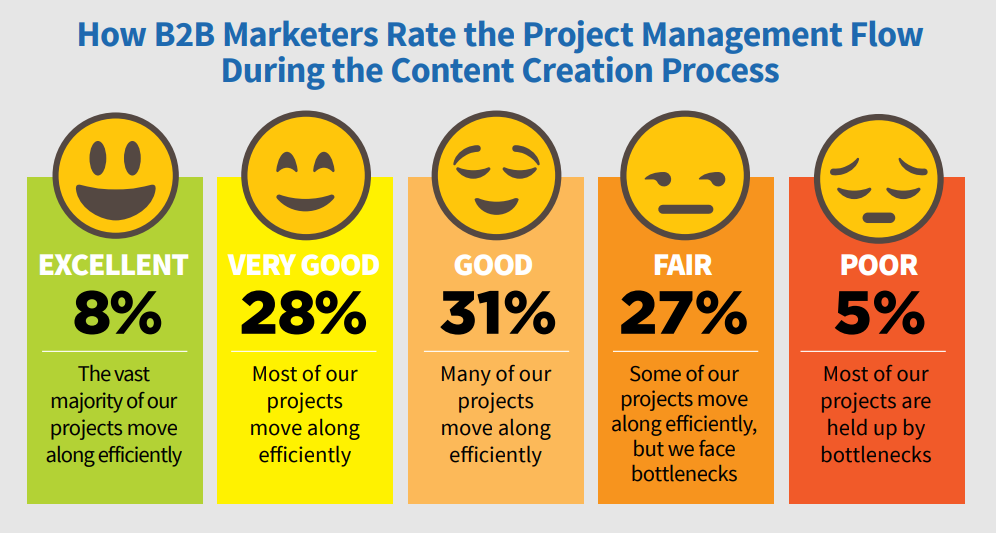
When I was in high school, we had a science class project in which we were grouped into teams, and tasked with building a catapult. Whichever contraption could launch a tennis ball the farthest would win the contest.
We quickly learned that the hardest part wasn’t constructing the actual catapult. It was wrangling all the team members, divvying up assignments, and keeping a collective group of energetic teenagers on track. In hindsight, maybe that was the point.
Managing Content Marketing Projects and People
Content marketing managers deal with these types of responsibilities on a daily basis. There are so many roles and functions typically involved with a time bound content initiative that we often must act as project managers, facilitating collaboration and ensuring that everyone is in a position to succeed.
That’s tricky, because in most cases content marketing managers are not trained in project management. Your team is (probably) not a bunch of rambunctious high schoolers, but creatives and specialists can be fickle, and we all know that keeping them happy and harmonious is essential to producing quality work.
It’s also something the business world at large could be doing a better job at. According to the 2019 In-House Creative Management Report from inMotionNow and InSource:
- Only 45% of creative and marketing professionals report that morale on their team is high
- 72% say that “obtaining the necessary information to get started on a project” is the biggest administrative task that consumes their time
- 22% opine that collaboration between creative and marketing is ineffective
This study represents just one system in a much larger galaxy, but the results feel universally reflective. In the B2B content marketing realm specifically, the 2018 benchmarking report from CMI and MarketingProfs found about one-third of respondents rating their project management flows as Fair or Poor, with only 8% deeming theirs Excellent. (The 2019 report didn’t ask this question, but we’re guessing the percentages would’ve been similar.)

(Source)
In the symbolic emoji measurement scale above, how can we shift the faces on our team from glum/shifty-eyed to smiling/delighted? Many organizations don’t have dedicated project managers on staff — or don’t have them available to assist with content programs directly — so this often falls on the content marketing managers themselves.
How to Improve Content Marketing Project Management
While orchestrating a variety of different individuals — all with their own personalities, preferences, and styles of working — can be highly challenging, there is a science to collaboration. So let’s map out some ways you can catapult your team to greater results.
Start with Creative Briefs
We’ve been harping on the importance of documenting content strategy, and creative briefs are important incremental steps in this process. This was a key theme in the aforementioned In-House Creative Management Report, which found teams that receive adequate information at project kickoff are:
- 26% more likely to say marketing leadership is effective
- 23% more likely to report high morale
- 14% more likely to get projects approved in three days or less
A good creative brief outlines expectations and deliverables for everyone involved, sets clear timelines, and firmly states the project’s objectives. It will take more time upfront to develop a comprehensive creative brief, but it pays off in the long run because team members can reduce confusion and answer their own questions.
Keep Communication Lines Open
Even with the right groundwork in place, it’s inevitable that things will pop up over the course of a project requiring back-and-forths with multiple team members. There is a delicate balance in enabling snappy and responsive communications while ensuring creatives have the uninterrupted time they need to produce.
There’s no one-size-fits-all solution here. One company’s ideal communication methods will look vastly different from another’s. In some cases, daily standup/huddle meetings (popularized by the agile framework) are just the ticket. For others, an office communication tool like Slack or Skype is preferred. And sometimes even plain old-fashioned email can suffice, although this seems increasingly rare.
The best approach is to continually consult with your people and absorb their feedback. Figure out what works best for them and tailor it to the needs of your project.
Find the Right Tools and Partners
We mentioned a couple of popular office collaboration platforms in the previous section. There are others built specifically for project management — such as Trello, Workfront, and Basecamp — and others still that are customized for content marketing initiatives. These platforms include Contently, CoSchedule, DivvyHQ, Kapost, Percolate, and more.
If you manage a large, distributed team that produces high volumes of content, it might be worth your while to invest in such a solution for centralized organization and coordination. Many of the options offer free trials.
Additionally, you might consider working with a partner to can lighten your load with time- and resource-consuming projects. For example, an experienced agency that specializes in content marketing (I can think of at least one!) reduces stress in numerous ways, freeing up your people to fully plug into their own work while offloading much of the management and execution.
Standardize Your Review and Approval Processes
This has been an internal focus for us at TopRank Marketing. Quality assurance is a vital component of the content production process, and one where things frequently get bogged down. Nailing down the various considerations above will help smooth out reviews and approvals that push content over the hump.
There are a lot of handoffs, prompts, and dependencies in play during QA, so it’s critical to have those communication lines locked down. Editorial calendar and content management software frequently has built-in workflows for multiple rounds of review. A detailed creative brief will also help provide structure for edits and feedback.
Putting the Pieces Together
Ideally, you’d have a dedicated project manager running point on your content initiatives. But in reality, these responsibilities often fall on the content marketing manager’s shoulders, meaning we need to put on our PM hats and guide the ship as best we can.
Pushing projects to completion, efficiently and exceptionally, isn’t all that different from building a catapult or any other class project. It’s all about understanding your people, establishing clarity with everyone involved, and giving them the tools, partners, and resources they need to succeed individually.
If you’re curious about how my team’s catapult turned out, we decided to put our own twist on the assignment. We jury-rigged a spring-loaded baseball bat that — once triggered — swung forth powerfully and drove the tennis ball like a hundred yards.
Unfortunately we were disqualified from the contest because we failed to adhere to the actual guidelines.
I suppose that if our group had a documented plan, superior communication, suitable tools, and a more stringent review process, we might’ve delivered something more in line with the actual objective.
I guess I did learn something that day. Certainly not how to build a catapult.
Efficiency is often top of mind for any content marketing manager. How can you enhance your ability to manage your work and save time. Check out these tips to overclock your B2B marketing efficiency.

Comments are Closed